ABSTRACT (PROJECT BACKGROUND & RESEARCH APPROACH)
Whole Foods Market is interested in bringing a healthy lifestyle, with an emphasis on healthy eating, to US college students.
Team Ampersand interviewed nineteen undergraduate and grad students ranging in age from 19 to 35 in the San Francisco Bay Area. In addition to the interview, we conducted a collage activity with them to learn more about their motivations and ideas about food and health.
From this data, we formulated insights that led us to our final concepts.
OBJECTIVE
We wanted to explore the attitudes and behaviors of college students towards healthy eating, see where the organic grocery Whole Foods fit into the picture, and propose a fresh solution to address the insights that we uncovered in our research.
We felt that our target audience of college students aged 19 to 35 was important to research because of their presumed roles as future leaders. With higher education, they are more likely to attain positions of influence, be role models and be prominent members of their communities. Targeting this population could have a significant trickle-down effect as concerns about health care costs associated with diet-related illnesses skyrocket.
KEY QUESTIONS
We formulated four key questions that served as the basis of our research.
1) In addition to budget, what factors determine what foods students eat and buy, and what role does cultural background play in determining these habits?
2) How do students define healthy eating and lifestyle and where do they get their information?
3) What prompted any drastic changes to students' wellness habits?
4) How do food trends start and disseminate among students?
PARTICIPANTS PROFILE
Our participants ranged in age from 19 to 35 and included undergraduates and grad students in the SF Bay Area.
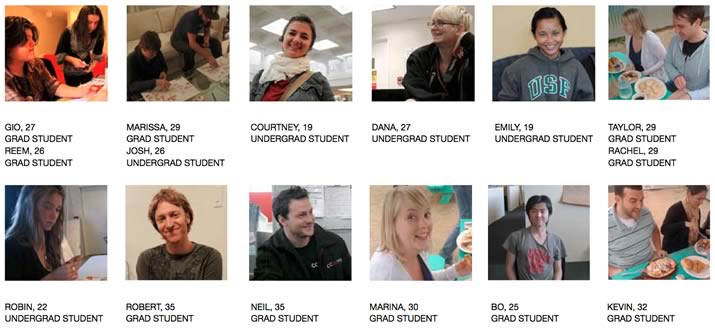
RESEARCH APPROACH
Team Ampersand took a diversified approach to our research on the health habits of college students, trying out several different methods before settling on our final tools. In addition to the final main collage activity and in-person interview, we set up an online food journal on a Facebook page, shadowed students while they shopped at Whole Foods, watched students eating, conducted refrigerator inspections, set up a Polyvore collection with the intention of doing Skype interviews and online collages, interviewed a college cafe manager and reached out to a New York Times food writer.

The purpose of the collage activity and interview was to gather some data about what kinds of foods students ate on a regular basis and what they considered healthy and unhealthy. The collage activity, which was done before the interview, also served as a good starting point for a discussion of student habits since it got respondents thinking about why they made certain decisions.
We interviewed people in their homes as well as in public dining places.

For our collage activity we tried to choose a variety of images that were ambiguous enough to appeal to different people's interpretations. For example, we used different images of salads, a regular green salad and a less healthy salad with dressing. Here is a graph showing the foods that respondents talked about the most and what they considered healthy.
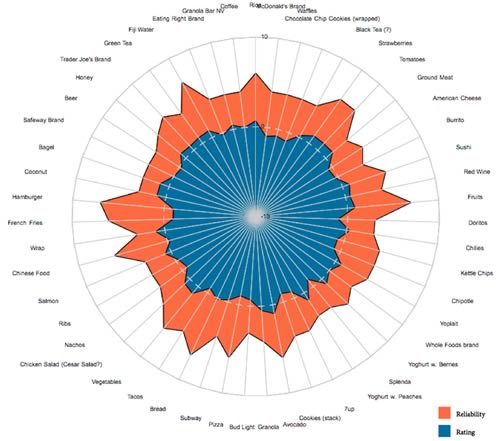
Once we finished the interviews, we wrote quotes and findings on Post-it notes and created an immersive space. We then clustered our findings into similar categories and from those groupings determined our key insights.
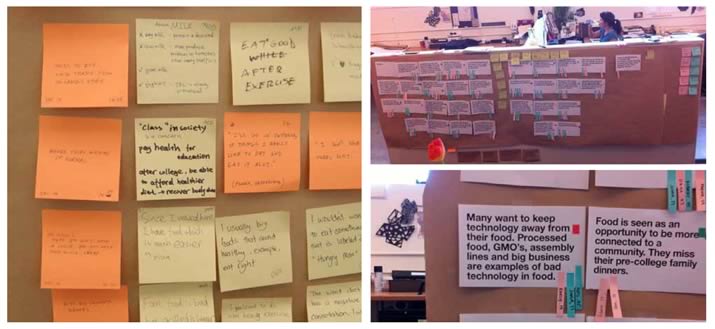
KEY INSIGHTS
Our first key insight is that a student's primary need for convenience often conflicts with a desire for food that is healthier, varied, and/or local.
Secondly, we found that students' desire to feel connected to smaller, simpler methods of food production, such as was practiced in the past, conflicts with the reality of being modern urban dwellers.
We charted these insights into a model showing the conflict between convenience and slow food, exploration and nostalgia.
We identified four personas in the course of our research that inhabited different parts of our model:
Regardless of differences in students' food preferences, all of them universally expressed that convenience was the most important factor in determining what, where and how they ate. Everyone talked about being constrained by time and location and would often end up eating the same few things week after week, which created boredom and lack of pleasure in eating. Budget restriction was a significant factor but not as much as a lack of time. Some would desire to eat differently and were conscious of compromising because of a lack of time.
The following video is a good conclusion from our interviews:
EAT SLEEP STUDY a day in my life - design research findings on college students' diet from April He on Vimeo.
AREAS OF OPPORTUNITY
Key areas of opportunity lie in providing a way for students to obtain “slow food” quickly and conveniently. It should appeal to their sense of nostalgia while offering something new. It should appeal to their emotional as well as rational sides. The concept should meet student desire to feel a sense of indulgence, experience a sense of variety and surprise as well as meet their desire to be connected to a sense of place. As future leaders, there should be an educational opportunity for them.
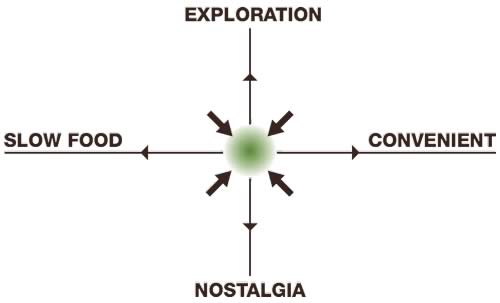
CONCLUSIONS/ RECOMMENDED SOLUTIONS
1)
Our first recommended solution is a Whole Foods Mobile Market. A clean running biodiesel vehicle, the Mobile Market will bring the fun of the farmers market experience directly to time-strapped students. In addition to providing healthy meals from seasonal ingredients, it will feature produce and products from a rotating roster of local farms. First and foremost, it will be convenient, catering to all students regardless of their other preferences. It will satisfy student desire for sustainably produced, local, and healthy foods. It will provide a variety of changing products to keep students interested and coming back as well as have some consistent inventory for those who prefer routine. It will satisfy student desire to indulge and treat themselves, but to feel good about doing it. The format of the vehicle will tap into the current vogue for high-end food trucks as well as a nostalgia for vehicles such as ice cream trucks. It will be an ambassador for Whole Foods to connect with a community beyond its few store locations. To differentiate it from the stores, it will be a lab of sorts, showcasing vendors and farms that Whole Foods is considering featuring in its stores.
The Mobile Market will have a companion website. The site will be a tool for connection, education, and community. Through the site, students will be able to locate the truck and see its schedule as it moves around the city. They will be able to learn about featured products, the farms they come from, and how to maintain a balanced diet that is good for them and the planet. They will be able to provide feedback about the items featured on the truck, creating a sense of ownership and empowerment. Students will be able to create a profile where they will be able to design a healthy diet. The site will make suggestions for the student and help them learn in a way that is interactive, hip, and engaging.
[chart]
Through the Mobile Market and Website, Whole Foods will have the opportunity to improve student health and wellness while enhancing its position as a company connecting small farms to urbanites.


2)
Another concept we considered is an interactive vending machine. As well as providing healthy farm fresh food, the act of getting the food will include a gesture that mimics the act of picking fruit. The machine will have educational components like a live video stream connecting the produce to the farm it came from.
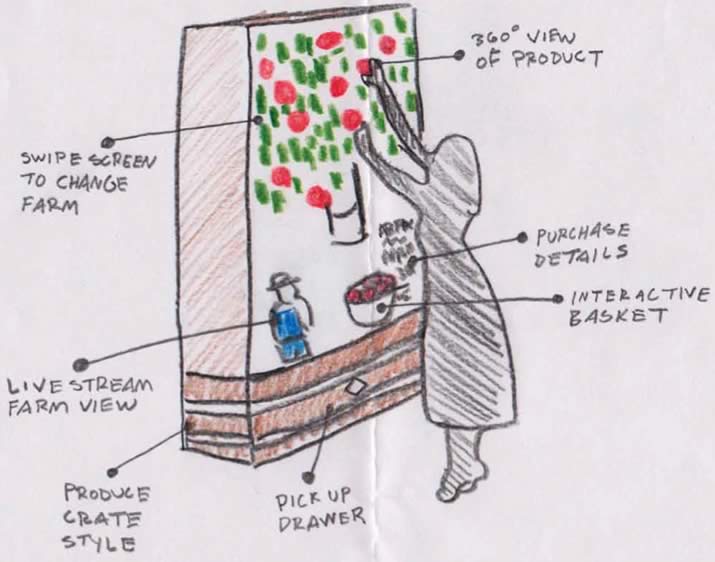
Our final report:
Course Instructors: Brenda Laurel, Long Jiao, Christopher Ireland, Pam Paradiso
Team member: Zena Adhami, Matthew Bowers, Tan-ya Gerrodette


